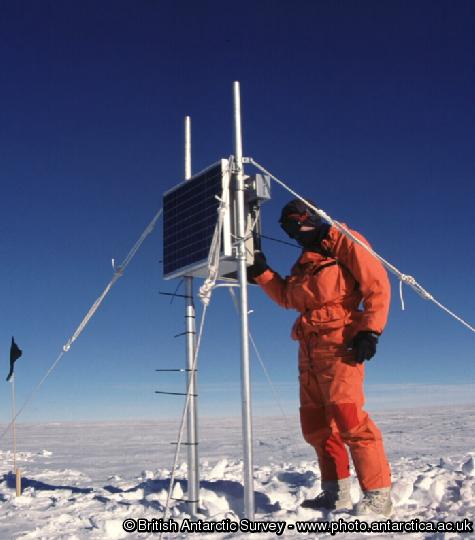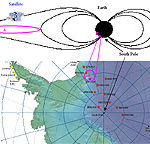The LPMs operate unmanned all year round, including the long winter, when continuous periods of darkness and temperatures as low as −80°C prohibit human intervention. This has been made possible by new technology which allows the magnetometers to use very little power and survive the winter on solar power stored during the summer. The network measures magnetic fluctuations over a wide area. The data can be used to produce maps of space weather in the region around the earth where satellites orbit.

Information is recorded in this part of the instrument and removed once a year. The black solar panel providing the power can be seen facing towards the camera. The magnetometer detector is about 10 m away.
Science
Magnetometers measure the earth’s magnetic field in three dimensions and have a wide variety of uses in earth and space science. They are used at all latitudes but are particularly valuable near the poles for space studies. The reason for this is the fashion in which the earth’s magnetic field lines are arranged, running parallel to the earth at the equator and grounding near the poles, see figure 1. Effects in near-earth space (geospace) are transmitted and focussed by the magnetic field towards the poles. An obvious effect of this is the aurora, a ring of light around the poles. “The magnetic field acts as a kind of lens for seeing geospace from the ground”, said Dr. Mervyn Freeman, lead scientist for the project. “Electric currents caused by space weather are focused here. The magnetometers are sensitive enough to measure the tiny perturbations these electric currents produce and space weather patterns can be mapped out.” This is not just of academic interest. The ability to predict space weather could help insurance, telecommunications, and aerospace industries to better protect spacecraft costing upwards of 200 million US dollars. In theory the LPMs could be deployed at either pole but the Antarctic provides a greater land area on which to site the instruments.
Engineering
The harsh Antarctic environment, however, imposes conditions on the instruments that can be used. The most southerly locations are inaccessible during the winter and the number of aircraft flights are limited. “Logistics is the main constraint”, said Mike Rose,who is in charge of engineering for the project. “We have a limited number of flying hours so the magnetometers have to be easy to deploy and maintain. We have designed them so literally anyone with the right training can service them. No specialist scientific knowledge is needed.”
According to Rose, what makes the LPMs unique is a “technical trick” which allows them to operate using very little power (0.5 watts, less than a single Christmas-tree light). They switch on only for the minimum amount of time needed to take a measurement and then switch themselves off again. Solar power is utilised over the summer and the excess power is stored in batteries. In the winter, the sun may be absent for up to five months so using solar power is not an option. During this time they run on power from the batteries alone. This means they can be left to operate without human intervention with merely a yearly visit to collect data. “The longest we have left a LPM completely unattended is 405 days” continued Rose, “When you consider the complexity of the instruments, which include a computer to store data, this is pretty impressive”.
However, the project presents some further technical challenges. In the most southerly locations, very low temperatures impair the performance of the batteries. Experiments using wind generators to provide extra power, have proved useful but these too can be affected by the cold and fail at temperatures below −60°C.
While the annual service takes an easy 10 minutes to perform it too is not without its risks. The highest LPM site is at an altitude of 10 500 ft that can present a risk of altitude sickness for those servicing the instruments.
So far the new LPM network has been successful in taking accurate magnetic measurements and overcoming the harsh environment. Progress is being reviewed and performance improvements continue to be made.
For more information contact:
- Lead scientist: Mervyn Freeman
